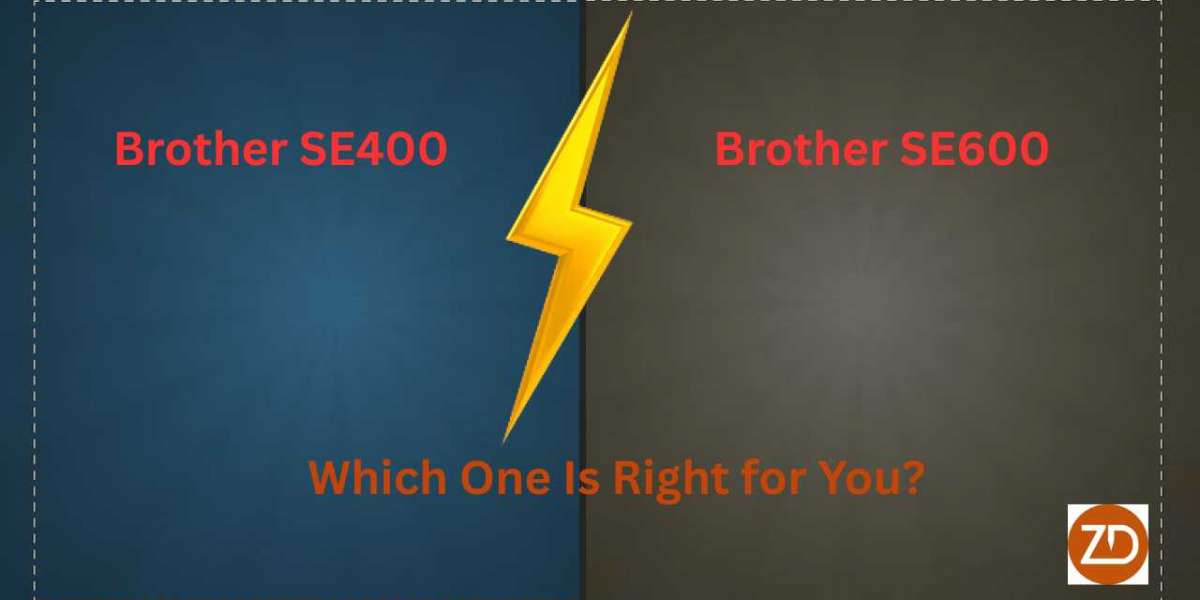In the world of affordable sewing and embroidery machines, the Brother SE400 and SE600 stand out as popular combo options for beginners and hobbyists in 2025. Both models offer a blend of sewing versatility and basic embroidery capabilities, but with key differences in features, performance, and usability. The SE400, an older model, provides solid value for simple projects, while the SE600, its updated successor, brings modern touches like a color touchscreen. Priced around $300–$400 for the SE400 (often discontinued or used) and $400–$500 for the SE600, these machines are budget-friendly entry points. This comparison dives into their specs, pros, cons, and user experiences to help you decide which fits your needs—whether you're stitching quilts or personalizing shirts. For custom designs, both support USB imports, making them compatible with services like ZDigitizing for PES files.
Overview of the Brother SE400
The brother se400 is a discontinued but still available used or refurbished combo machine, known for its reliability as an intermediate sewing tool with beginner embroidery. Compact and lightweight (~15 lbs), it's easy to store and transport. It features a monochrome LCD screen, 67 built-in sewing stitches with 98 functions, and 70 embroidery designs with 5 monogramming fonts. The 4" x 4" embroidery area suits small projects like logos or monograms, and it includes a USB port for importing designs. Automatic needle threading and a built-in embroidery card slot add convenience, though it lacks advanced editing. Users appreciate its even stitching and value, making it a "wonderful machine" for everyday tasks.
Overview of the Brother SE600
The Brother SE600 is a newer, still-available combo machine that's an upgrade from the SE400, featuring 103 built-in sewing stitches (including 10 one-step buttonholes) and 80 embroidery designs with 6 lettering fonts. Its 3.2" color LCD touchscreen allows previewing and basic editing, a step up from the SE400's monochrome display. With a 4" x 4" embroidery area, USB import for PES files, and features like variable speed control and drop feed for free-motion sewing, it's user-friendly for beginners. At 710 stitches per minute for sewing, it's efficient for home projects, and reviews call it a "solid 9 out of 10" for ease.
Key Differences Between SE400 and SE600
The SE600 is essentially an updated SE400 with enhancements for better usability. Here's a side-by-side comparison:
- Sewing Stitches: SE400 has 67 stitches; SE600 offers 103, including more decorative options.
- Embroidery Designs: SE400 includes 70 designs and 5 fonts; SE600 has 80 designs and 6 fonts.
- Display: SE400's monochrome LCD is basic; SE600's 3.2" color touchscreen enables previews and easier navigation.
- Connectivity: Both have USB for PES imports, but SE600 lacks an embroidery card slot (SE400 has one).
- Embroidery Area: Identical 4" x 4" hoops for small projects.
- Other Features: Both offer automatic needle threading and thread cutter, but SE600 adds variable speed and drop feed for free-motion.
The SE600's color screen and extra stitches make it the clearer upgrade.
Pros and Cons of Each Machine
Brother SE400 Pros and Cons
Pros:
- Affordable and reliable for basic sewing/embroidery.
- Compact with easy threading and even stitching.
- USB and card slot for designs.
Cons:
- Monochrome screen limits previews.
- Fewer stitches/designs than newer models.
- Discontinued, so parts/support may vary.
Brother SE600 Pros and Cons
Pros:
- Color touchscreen for better usability.
- More stitches (103) and designs (80) for versatility.
- User-friendly for beginners with automatic features.
Cons:
- No embroidery card slot.
- Small 4" x 4" hoop limits larger designs.
- Occasional app glitches (though updated).
User Experiences and Feedback
Users of the SE400 praise its dependability for simple tasks, with one reviewer noting "very even stitching" for quilts. However, the monochrome screen feels dated, and it's harder to find new units.
The SE600 gets higher marks for its color screen and ease, with a Quora user calling it "pretty damned good for the money" and beginner-friendly. A Reddit thread recommends it for fun projects, though some suggest the PE800 for larger hoops. Both machines handle custom PES files well from ZDigitizing, but the SE600's interface makes editing simpler.
Which One Is Right for You?
- Choose the SE400 if: You're on a tight budget, need basic sewing/embroidery, and can find a used/refurbished unit. It's great for simple monograms or repairs but feels outdated.
- Choose the SE600 if: You want a modern touchscreen, more stitches/designs, and better previews for beginner embroidery. It's the superior upgrade for home use.
For larger hoops or wireless, consider newer models like the SE700. Both support ZDigitizing for custom files.
Conclusion
The Brother SE400 vs SE600 debate favors the SE600 for its color screen, extra features, and usability, making it the better pick for most beginners in 2025. The SE400 remains viable used but lacks the updates that make the SE600 more enjoyable. Test in-store if possible, and pair either with ZDigitizing for pro designs. Whichever you choose, you'll unlock creative potential on a budget.
Frequently Asked Questions (FAQs)
Is the SE600 worth the upgrade from SE400? Yes, for the color screen and more stitches.
Both have 4x4 hoops? Yes, suitable for small designs.
Custom designs supported? Yes, PES via USB; ZDigitizing compatible.
Warranty for used SE400? Varies; new SE600 has 25-year limited.
Best for beginners? SE600's touchscreen edges it out.
SE600 sewing speed? 710 SPM.







